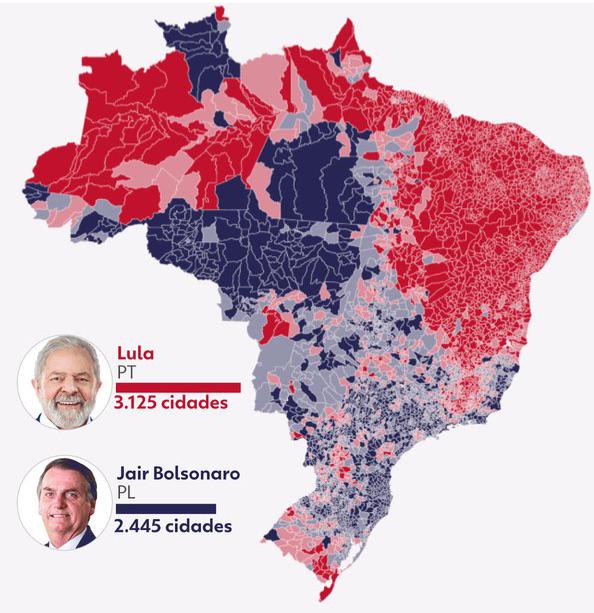Brazil Presidential Elections 2022 Map by Municipality


Marcus Rodriguez
Historical Geography Expert
Marcus Rodriguez specializes in historical cartography and geographic data analysis. With a background in both history and geography, he brings unique...
Geographic Analysis
What This Map Shows
The visualization titled "Brazil 2nd round presidential elections - Lula x Bolsonaro (2022) by municipality" provides a detailed breakdown of the electoral results from the second round of Brazil's presidential elections held in October 2022. It highlights how each municipality in Brazil voted between the two prominent candidates: Luiz Inácio Lula da Silva, representing the Workers' Party, and the incumbent president Jair Bolsonaro, associated with the Liberal Party. The map uses color coding to indicate the winning candidate in each municipality, revealing patterns of support and political divides across the country.
Deep Dive into Brazil's Political Landscape
Brazil's political landscape has long been characterized by a rich tapestry of regional loyalties and historical influences. The 2022 elections were particularly significant, as they represented a pivotal moment in the country’s democratic journey. Lula's return to power, after serving two terms from 2003 to 2010, marked a significant shift after a tumultuous period under Bolsonaro's presidency, which was often described as controversial due to his handling of various issues including the COVID-19 pandemic and environmental policies.
Interestingly, the electoral map reveals striking regional disparities in voting preferences. For instance, Lula found considerable support in the northeastern states, where poverty and social inequality remain pressing concerns. This area has historically leaned towards leftist candidates, largely due to Lula's earlier social programs that significantly reduced poverty and improved education during his previous terms in office. Municipalities like Recife and Salvador showed overwhelming support for Lula, reflecting a desire for a return to more progressive governance.
On the other hand, Bolsonaro's support was particularly strong in the southern and central-western regions, areas that are often characterized by agribusiness interests and more conservative social values. States like Santa Catarina and Mato Grosso do Sul exhibited significant backing for Bolsonaro, which can be attributed to his focus on agrarian policies and a tough-on-crime stance that resonated with voters in these regions.
The divide between urban and rural areas is also noteworthy. Urban centers such as São Paulo and Rio de Janeiro leaned towards Lula, likely influenced by younger voters who are more aligned with progressive values, while rural municipalities tended to favor Bolsonaro. This urban-rural divide illustrates broader trends in Brazilian society, where access to education, economic opportunities, and cultural influences play critical roles in shaping political preferences.
Regional Analysis
Diving deeper into the regional analysis, we can see that the northeastern states, including Bahia and Ceará, are not just political strongholds for Lula but also areas that benefited significantly from his social welfare programs. These states have some of the highest poverty rates in Brazil, and Lula’s promises to revitalize these social programs resonated deeply with voters who have experienced years of economic challenges.
Conversely, in the southern region, particularly in Rio Grande do Sul and Paraná, Bolsonaro's policies aimed at deregulating various sectors of the economy found favor among voters. The agribusiness sector, which is a major economic driver in these states, saw Bolsonaro as a candidate who would protect their interests from environmental regulations that they viewed as restrictive.
What’s fascinating is how the map illustrates Brazilian cities as battlegrounds of ideology. For instance, the metropolitan area of São Paulo, which is often seen as a microcosm of the country’s diverse cultural and economic landscape, displayed mixed results. While the city itself leaned towards Lula, surrounding municipalities had varying degrees of support for Bolsonaro, showcasing the complexity of urban voting behavior in Brazil.
Significance and Impact
Understanding the electoral results displayed on this map is crucial not only for grasping the current political climate in Brazil but also for anticipating future developments. Lula's presidency is likely to focus on addressing social inequalities and promoting environmental sustainability, particularly following concerns raised about deforestation in the Amazon during Bolsonaro's tenure.
Moreover, the implications of the 2022 election extend beyond Brazil's borders. As a member of the BRICS nations, Brazil's political direction influences regional dynamics in South America and can impact global discussions on climate change, trade, and economic cooperation.
As Brazil continues to navigate its political landscape, one must consider how these electoral patterns will shape policy decisions and societal attitudes moving forward. The stark contrasts illustrated on this map serve as a reminder of Brazil's diverse political fabric and the ongoing challenges the nation faces in uniting its population under common goals for the future.
Visualization Details
- Published
- September 13, 2025
- Views
- 64
Comments
Loading comments...